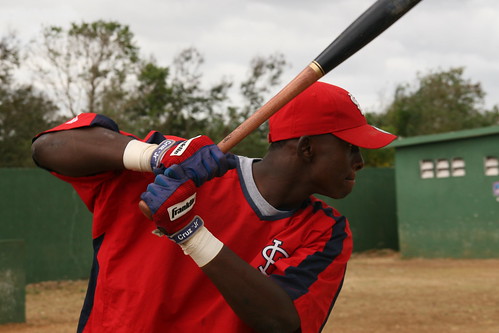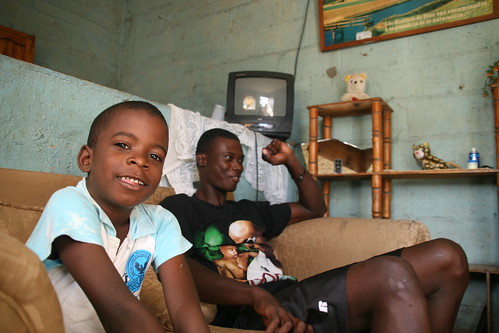
Tigers Prospect Scott Drucker and Joshua Kusnick at the Moves Magazine Super Bowl Party.
Camden Depot, among other blogs, often overlooks the contribution made by sports agents and their effect on the game. In response to that common oversight, we invited Joshua Kusnick here today to discuss the path he took in becoming an agent for baseball players, discuss Frabizio and Bell, and his beliefs in how an agent should represent his clients.
Entire interview after the jump.
Camden Depot: I have read that your start in scouting was rather unique in comparison to other agents. Could you introduce the reader to your background and how you think that helps you secure and well represent your clients?
Joshua Kusnick: My career in sports started when I was around 10 years old. I had the opportunity to be the batboy for the Orioles during spring training a couple of times when I was a kid so that was really my first exposure being around a big league club house. During my teenage years, actually when I was 14 years old, I began getting autographs of minor league baseball players. Most of the games I attended were in West Palm Beach watching Florida State League baseball, so I had the good fortune of watching guys like Vlad Guerrero, Brad Fullmer, Roy Halladay, Matt Morris, Freddy Garcia, Ramon Castro etc….
During one of these games, I believe it was my last year of getting autographs so that had to be the year 2000, I was sitting next to a scout who basically changed my life forever. We chatted the entire game, he gave me his card and over the course of several months we developed a pretty good friendship. He told me if I ever wanted a job in scouting to let him know so in time that’s exactly what I did. Back before everything was readily available on the internet I crunched all the draft figures for this scout every year in addition to doing some very low level unofficial bird dog work. After a couple of years of part time work I decided to start my company with my father and the rest is history.
I feel one of the advantages I have in this field is my ability to independently evaluate talent. Some agents rely on scouts and some even hire scouts to find players for them because they lack the ability to determine a player’s ultimate value. I am beyond fortunate that I don’t have to rely on anyone other than myself to scout players. The fact that I can scout does not mean I don’t talk to other people in the game to get their input on certain players and it doesn’t mean that I’m right far more than I’m wrong but what it does do for me is provide a slight edge on some of the competition. When you represent a player you have to know what you’re selling. You have to know your product better than anyone else because you’re making a long term commitment that will cost you ample time and money, so you better be damn sure you know what you’re getting yourself into and lucky for me, I usually do.
 CD: Vito Frabizio is a client of yours who has also taken a unique route to the professional ranks. We here at Camden Depot first took note of Frabizio in Perfect Game's 2008 World Showcase. How did you come to represent him and how would you describe his current talent and his progression as a ball player since you can to represent him?
CD: Vito Frabizio is a client of yours who has also taken a unique route to the professional ranks. We here at Camden Depot first took note of Frabizio in Perfect Game's 2008 World Showcase. How did you come to represent him and how would you describe his current talent and his progression as a ball player since you can to represent him?JK: I met Vito through a mutual friend during the 2008 off season. Vito was working out at my old high school American Heritage in plantation Florida, a school where I represented two players who were drafted that year (JC Sulbaran and Adrian Nieto). Vito is like a brother to me and we clicked instantly. Our personalities are quite similar and we’ve shared a lot of the same experiences in life so getting hired wasn’t terribly difficult fortunately. Vito has added some weight to his frame since we signed him which has made a world of difference on the field. His ability to throw multiple pitches for strikes has improved in addition to adding velocity to his fastball since we’ve represented him. Vito is a very special young man and the sky is the limit when it comes to his potential. It’s all going to come down to his attitude and his health.
CD: Your client, Josh Bell, has always been on the periphery of scouting lists, but really established himself as a prime prospect this past year by making great progress in his defense at third and his development from the left side of the plate. Keith Law mentioned that Bell has a promising career in front of him, but is still a work in progress. It was also mentioned that the Orioles have a better development program than the Dodgers, which took me by surprise. From your perspective, what new opportunities or benefits opened up for Bell when he was traded to the Orioles?
JK: I think very highly of both organizations with respect to player development. We have several Dodgers prospects in our company (Trayvon Robinson, Kenley Jansen, Justin Sellers) as well as several Orioles prospects (Josh Bell, Jonathan Tucker, and Vito Frabizio). I feel that all these kids have been given every chance to succeed in their respective organizations. The Dodgers always viewed Josh as a very special prospect and I know it was difficult for guys like [Assistant General Manager (Player Development)] De Jon Watson and [Assistant General Manager (Amateur/International)] Logan White to give up Josh in the Sherrill trade last season. I think Josh had a great chance to make an impact with the Dodgers over time but it seems he’s on the fast track to some extent now that he is with the Orioles. Baltimore seems to have a clear plan in place for Josh and I think this trade was the best thing to happen to Josh since signing his first contract out of high school.
CD: Another question about development . . . to what extent do you think an agent should encourage his client to disagree with his organization? For instance, in the Orioles system there have been alleged instances where a player's individual trainer/coach has provided contradictory instruction in comparison to the team's instructors. Do you think an agent should encourage third party instruction or evaluation? How do you handle such a situation as I imagine the organization likes to act with as few people in the decision making process as possible?
JK: My responsibility always is to the player. Obviously it is mutually beneficial for the player, the agent and the team to all be on the same page because ultimately all three parties are working towards the same goal but at the end of the day I will always side with my client. I think an agent should always work towards the best interests of his clients no matter what. I also think a player should always do what he feels is in his best interests regarding his career. An agent is the player’s voice to his organization and that comes with a great deal of responsibility. Do players and the teams see eye to eye on every issue? No, but that’s what an agent is there for, to bridge the gap and hopefully come to a mutually beneficial conclusion.
CD: A week or so ago on your personal blog you commented on the Tiger Woods apology press release. I thought it to be a very interesting and informative look behind the scenes in what an agent does for the player and how each partner in this relationship is dependent on the other for success. I was hoping that you could elaborate on how you, as an agent, are involved with a player and his family beyond the contracts and interviews with the press?
JK: I literally am on call 24 hours a day for all of my players regardless of what I am doing. The long term goals of my career are directly dependent on my clients and how they perform on and off the field. Personally, I try to get as involved as I can with a player and his family. I get to know players wives, girlfriends, mothers and fathers. I’ve been in fantasy baseball leagues with some clients and their families, I go to dinner with many clients’ parents, I stay in touch with the players wives, girlfriends and families as much as they allow me to. Every relationship is up to the player. Some guys prefer to keep it business only and other players appreciate how involved I am willing to get in their lives and careers. I’ve had several players live with me and I take great pride in being as hands on as I am with respect to my clients lives off the field.
CD: I would like to thank Joshua Kusnick for taking time to discuss his practice and some of the players he represents.















